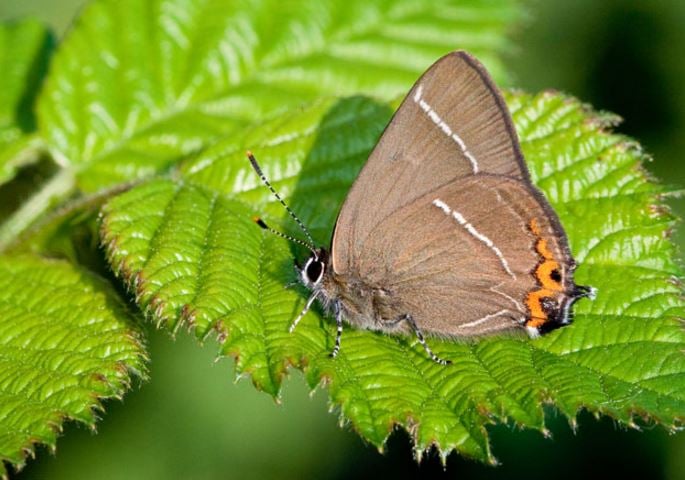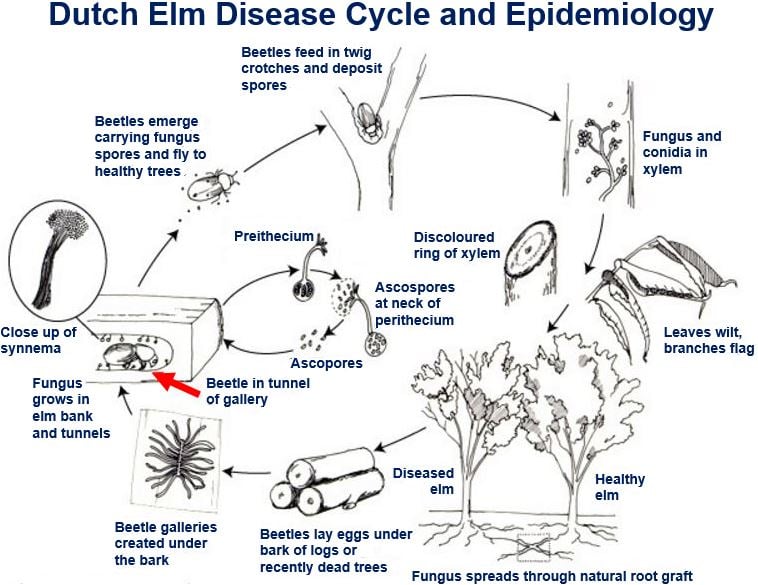A rare UK butterfly – the White-Letter Hairstreak – is facing extinction because its only habitat, English elm trees, are rapidly vanishing due to Dutch elm disease, a widespread disease. Over the past forty years, the White-Letter Hairstreak population has declined by 96%.
Over the past four decades, the number of elm trees in the UK has fallen by over 30 million. In fact, there are only about 1,000 mature English elms left in Britain, says The Wildlife Trust. An outbreak of Dutch elm disease in the 1970s and 1980s destroyed a huge number of trees.
 The White-Letter Hairstreak is a small butterfly which lives in the tops of elm trees throughout England and Wales. According to Butterfly Conservation, it is difficult to spot because it generally flies around the tops of trees. (Image: butterfly-conservation.org)
The White-Letter Hairstreak is a small butterfly which lives in the tops of elm trees throughout England and Wales. According to Butterfly Conservation, it is difficult to spot because it generally flies around the tops of trees. (Image: butterfly-conservation.org)
When English elms go so do White-letter Hairstreaks
According to The Forestry Commission, a non-ministerial government department responsible for forestry in England and Scotland, Dutch Elm disease is one of the world’s most serious tree diseases. It has killed more than 60 million British elms in two epidemics over the past century, and continues spreading today.
The first epidemic, caused by the fungus Ophiostoma ulmi, started in the 1920s. The second epidemic struck in the 1970s and was caused by the highly aggressive and related fungus O. novo-ulmi. It is spread by the elm dark beetle of the genus Scolytus. The fungus invades the water-conducting system of trees.
According to The Wildlife Trust, Dutch elm disease has had a ‘catastrophic’ effect on the rare White-letter Hairstreak butterfly (Satyrium w-album), so called because of the characteristic single white streak across its brown wings.
A report by the Centre for Ecology and Hydrology and Butterfly Conservation – The State of the UK’s Butterflies 2015 – informed that the abundance of Hairstreaks declined by 96% from 1976 to 2014, and by 77% from 2005 to 2014.
The Guardian quoted Ben Keywood, a butterfly specialist who works at The Wildlife Trust, as saying:
“White-letter Hairstreaks are a UK Biodiversity Priority Species as they spend their whole life cycle exclusively on elm trees.”
“The eggs will be on the tree for the next couple of months and then the caterpillars will feed on the leaves before pupating and becoming adult butterflies in July.”
 The earliest external symptoms of Dutch Elm Disease infection are often yellowing and wilting of leaves on individual branches. The leaves commonly turn brown and curl up as the branches die, and eventually may drop off. Typically, just part of the tree crown is affected, but symptoms often progress rapidly. Some trees die within just one year. (Image: apsnet.org)
The earliest external symptoms of Dutch Elm Disease infection are often yellowing and wilting of leaves on individual branches. The leaves commonly turn brown and curl up as the branches die, and eventually may drop off. Typically, just part of the tree crown is affected, but symptoms often progress rapidly. Some trees die within just one year. (Image: apsnet.org)
Mature English elm likely saved in Sheffield
The Trust’s Sheffield and Rotherham branch has supported a petition by Sheffield residents to protect an English elm in the Nether Edge area that is host to a colony of Hairstreaks. It had been destined for destruction by Sheffield County Council as part of a tree-replacement programme.
Dr Nicola Rivers, Living Landscape Development Manager of The Wildlife Trust for Sheffield and Rotherham, said:
“We hope that Amey and the council will listen to the local people and they can approve a solution which retains this important tree.”
 This is the English elm that Sheffield County Council may exclude from its tree-felling programme. It is listed as a Heritage Tree on the internationally recognised Tree Register. (Image: ancient-tree-hunt.org.uk)
This is the English elm that Sheffield County Council may exclude from its tree-felling programme. It is listed as a Heritage Tree on the internationally recognised Tree Register. (Image: ancient-tree-hunt.org.uk)
“As well as the butterfly, we also saw bullfinches and other birds using the tree, just on one visit – it would not just be the tree that would be lost, but all the biodiversity it supports.”
Sheffield County Council said it would reassess its plan to destroy the tree and promised it would take the Hairstreak colony into account.
A Council spokesperson said:
“We are aware of the tree in question. We are currently working with our contractor Amey to reassess it and other trees as part of our residents’ survey in that area. We have also recently been made aware of the findings relating to the butterflies and naturally this will be taken into account as part of this process.”
“Only once all results are in will any decisions be made about the future of this or other trees in the area. Trees are only ever removed if they are dead, dying, diseased, decaying or dangerous.”
Video – White-Letter Hairstreak

